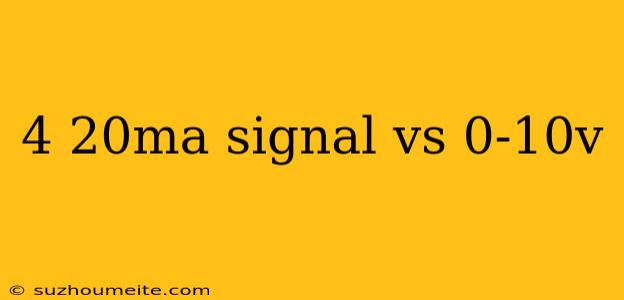4-20mA Signal vs 0-10V: Understanding the Differences
When it comes to industrial automation and process control, signal transmission plays a crucial role in ensuring accurate and reliable communication between devices. Two of the most commonly used signal transmission methods are 4-20mA and 0-10V. While both methods serve the same purpose, they have distinct differences in terms of their operational principles, advantages, and applications.
What is a 4-20mA Signal?
A 4-20mA signal is a type of analog signal used to transmit information from a sensor or transmitter to a receiver or controller. The signal is a proportional representation of the measured value, with 4mA indicating 0% and 20mA indicating 100% of the full scale. The signal is typically transmitted over a two-wire connection, with the power supply and signal transmission sharing the same wires.
Advantages of 4-20mA Signal:
- Long-distance transmission: 4-20mA signals can be transmitted over long distances without significant signal degradation.
- Noise immunity: The signal is less susceptible to electromagnetic interference (EMI) and radio-frequency interference (RFI).
- Simple installation: Two-wire connections are easier to install and maintain.
- Low power consumption: The signal requires minimal power to operate.
Disadvantages of 4-20mA Signal:
- Limited scalability: The signal is limited to a single loop, making it less suitable for complex systems.
- Resolution limitations: The signal has limited resolution, making it less accurate for precision applications.
What is a 0-10V Signal?
A 0-10V signal is another type of analog signal used to transmit information from a sensor or transmitter to a receiver or controller. The signal is a proportional representation of the measured value, with 0V indicating 0% and 10V indicating 100% of the full scale. The signal is typically transmitted over a three-wire connection, with separate wires for power supply, ground, and signal transmission.
Advantages of 0-10V Signal:
- Higher resolution: The signal provides higher resolution and accuracy compared to 4-20mA signals.
- Scalability: 0-10V signals can be easily scaled up for complex systems with multiple channels.
- Flexibility: The signal can be used for both analog and digital applications.
Disadvantages of 0-10V Signal:
- Signal degradation: The signal can degrade over long distances, affecting its accuracy.
- Noise susceptibility: The signal is more susceptible to electromagnetic interference (EMI) and radio-frequency interference (RFI).
- Complex installation: Three-wire connections are more complex to install and maintain.
Comparison and Applications
| 4-20mA Signal | 0-10V Signal | |
|---|---|---|
| Signal Range | 4-20mA | 0-10V |
| Resolution | Limited | Higher |
| Distance | Long-distance transmission | Signal degradation over distance |
| Power Consumption | Low | Medium |
| Applications | Industrial automation, process control | Laboratory equipment, precision instruments |
In summary, 4-20mA signals are suitable for industrial automation and process control applications where reliability, noise immunity, and simplicity are crucial. 0-10V signals, on the other hand, are better suited for applications requiring higher resolution, scalability, and flexibility, such as laboratory equipment and precision instruments. Understanding the differences between these two signal transmission methods is essential for selecting the most appropriate solution for your specific application.
